What is a fire door?
A fire door is a specially designed door that primarily prevents the spread of fire and smoke within a building. These doors are an essential component of a building’s passive fire protection system and can help protect lives and property by providing a barrier between different building sections.
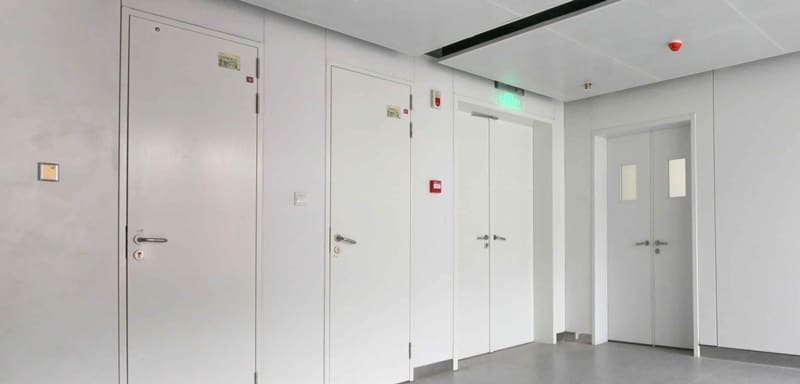
Fire doors are typically made from fire-resistant materials such as steel, timber, or glass and are constructed to meet specific fire resistance ratings. They can be found in commercial, industrial, and residential settings.
Some key features of fire doors include:
- Fire resistance rating: Fire doors are rated based on how long they can withstand fire exposure. Typical ratings are 30, 60, 90, or 120 minutes, depending on the specific requirements of a building’s fire safety design.
- Intumescent seals are installed around the edges of a fire door. In a fire, the seals expand when exposed to heat, sealing gaps between the door and the frame to prevent the spread of smoke and flames.
- Door closers: Fire doors are usually equipped with self-closing devices that ensure the door is permanently closed when not in use. This is important because an open fire door is ineffective in containing fire and smoke.
- Hardware and components: Fire door assemblies include specific hardware, such as hinges, locks, and latches, designed to withstand high temperatures and maintain the door’s integrity during a fire.
Fire doors must be installed, maintained, and inspected according to local building codes and regulations to ensure proper performance during a fire.
What is a fire exit door?

A fire exit door, also known as an emergency exit door, is a specially designed door that provides a safe and unobstructed means of escape from a building during emergencies, such as a fire. These doors are essential to a building’s fire safety and evacuation plan, allowing occupants to exit the building quickly and safely when required.
It is important to note that while some fire exit doors may also function as fire doors, not all fire doors are designed to be fire exit doors. Fire doors prevent the spread of fire and smoke within a building, while fire exit doors are specifically designed to provide a means of escape during emergencies.
What is a 20-minute fire-rated door?
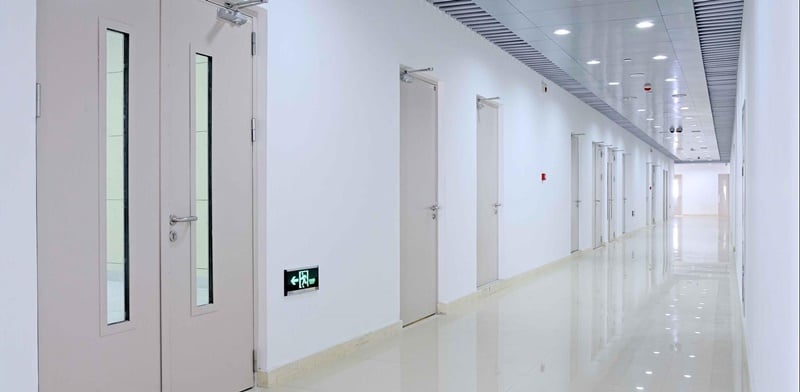
A 20-minute fire-rated door has been tested and certified to withstand exposure to fire for a minimum of 20 minutes before its integrity is compromised. Fire-rated doors are essential to a building’s passive fire protection system, preventing or slowing the spread of fire and smoke within a structure.
The fire resistance rating is determined through rigorous tests, during which the door is exposed to extreme heat and pressure to simulate real-life fire conditions. In the case of a 20-minute fire-rated door, it must maintain its integrity and not allow the passage of fire or excessive heat for at least 20 minutes during testing.
A 20-minute fire-rated door is typically used in residential or light commercial applications with a relatively low fire-resistance rating. Common locations for these doors include corridors, stairwells, and rooms that contain equipment or materials with a moderate fire risk.
How do fire doors work?
Fire doors provide a barrier to limit the spread of fire and smoke within a building. They are an essential part of a building’s passive fire protection system and help to classify the building, allowing occupants more time to evacuate safely and firefighters more time to respond. Here’s a general overview of how fire doors work:
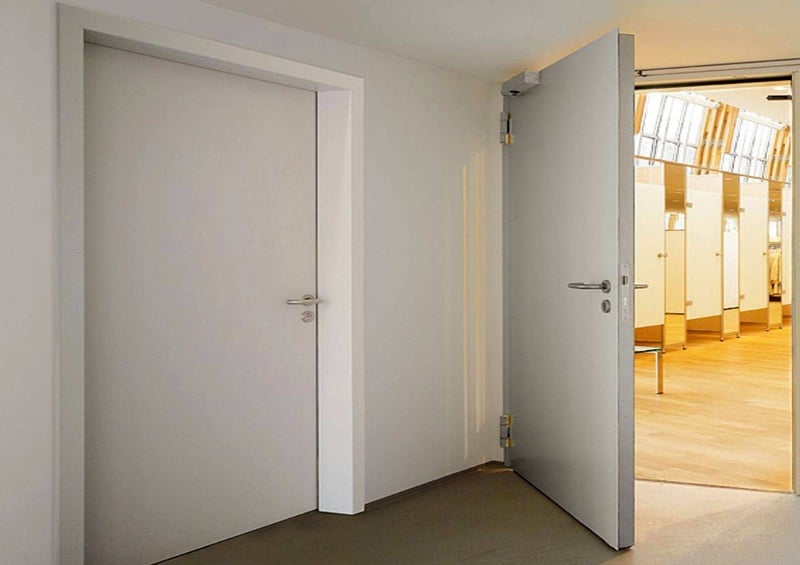
- Fire-resistant materials: Fire doors are made from materials that can withstand high temperatures, such as steel, timber, or glass, and are constructed to meet specific fire resistance ratings. These materials help prevent fire and smoke from spreading through the door.
- Fire resistance rating: The fire-resistance rating indicates how long a fire door can withstand exposure to fire. The higher the rating, the longer the door can hold back the fire and smoke. The rating is determined through rigorous testing, during which the entry is exposed to extreme heat and pressure to simulate real-life fire conditions.
- Intumescent seals: Fire doors are fitted with intumescent seals around the edges of the door and the frame. These seals expand when exposed to heat, filling the gaps between the door and the frame to prevent the passage of smoke and fire.
- Door closers: Fire doors are equipped with self-closing devices that ensure they remain closed when not in use. An open fire door cannot effectively prevent the spread of fire and smoke, so this feature is crucial to the door’s effectiveness.
- Regular inspection and maintenance: To ensure fire doors work correctly during a fire, they must be inspected, maintained, and tested periodically. This includes checking the seals, hardware, and self-closing devices for any signs of damage or wear that could compromise their performance.
When a fire occurs, fire doors help to classify the building by providing a barrier between different sections. This slows the spread of fire and smoke, allowing occupants more time to safely evacuate and giving firefighters a better chance to control and extinguish the fire.
What are the types of fire doors?
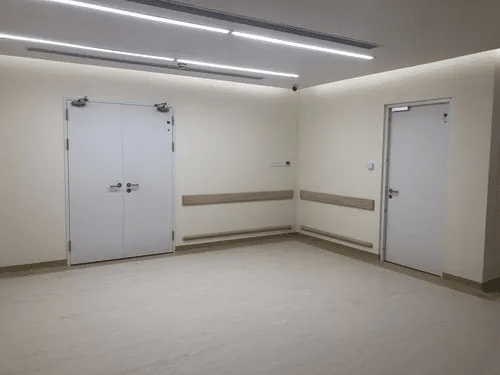
Fire doors come in various types, materials, and designs to meet specific requirements, building codes, and architectural preferences. The primary function of all fire doors is to resist the spread of fire and smoke within a building. Some common types of fire doors include:
- Timber fire doors: Made from fire-resistant timber, these doors are commonly used in residential and commercial buildings. Timber fire doors can have a range of fire resistance ratings, typically between 30 and 120 minutes, depending on the specific construction and materials used.
- Steel fire doors: Constructed from steel, these doors provide high fire resistance and are often used in industrial or commercial settings. Steel fire doors can have fire resistance ratings up to 240 minutes or more and are known for their durability and strength.
- Glass fire doors: Made from specially designed fire-resistant glass, these doors allow for visibility while still providing fire protection. They are often used in commercial buildings or areas where maintaining a line of sight is essential. The fire resistance ratings for glass doors vary but typically range from 30 to 120 minutes.
- Composite fire doors: These doors are made from a combination of materials, such as timber, steel, and fire-resistant cores, to provide enhanced fire protection. Composite fire doors can have fire resistance ratings similar to timber or steel ones.
- Fire-rated sliding doors: These are fire doors designed as sliding doors rather than the traditional swing door style. Fire-rated sliding doors are commonly used in large openings or areas where a swing door may not be practical.
- Fire exit doors: Also known as emergency exit doors, these doors are specifically designed to provide a means of escape during a fire or other emergency. Fire exit doors are typically equipped with panic hardware or push bars to ensure easy opening and must lead to a safe exit route.
Each type of fire door has advantages and applications, depending on the building’s specific requirements and design. Choosing the appropriate fire door type is essential based on the building’s fire protection strategy, local building codes, and fire safety regulations. Regular inspection, maintenance, and proper installation of fire doors are crucial for their effectiveness in a fire.
What are fire doors made of?
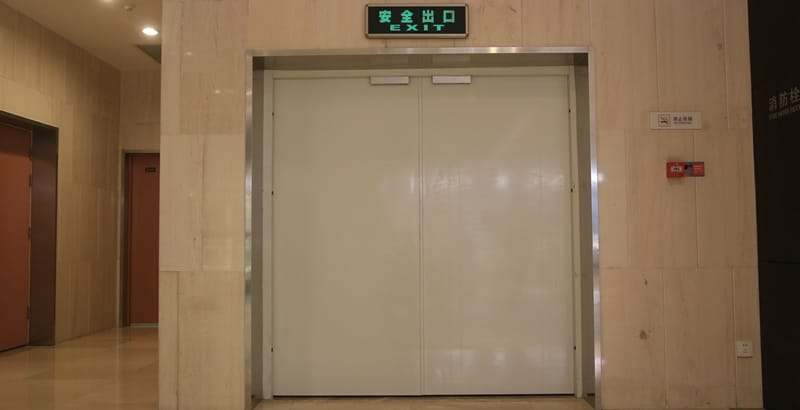
Fire doors are made from various fire-resistant materials designed to withstand high temperatures and prevent the spread of fire and smoke within a building. The choice of material depends on the specific application, fire resistance rating, and building requirements. Some common materials used in the construction of fire doors include:
- Timber: Timber fire doors are made from fire-resistant wood or wood-based materials, such as solid timber, particleboard, or medium-density fiberboard (MDF). These doors often incorporate fire-resistant cores or layers to enhance their fire resistance. Timber fire doors are commonly used in residential and commercial settings.
- Steel: Steel fire doors are constructed from steel sheets, often with fire-resistant core material, such as mineral wool, gypsum, or ceramic fiber, to provide additional insulation and fire resistance. Steel doors offer high fire protection and are frequently used in industrial and commercial buildings.
- Glass: Glass fire doors use specially designed fire-resistant glass to maintain its integrity during a fire while allowing visibility. These doors may be constructed entirely of fire-rated glass or feature glass panels within timber or steel frames. Glass fire doors are typically used in commercial buildings or areas where maintaining a line of sight is essential.
- Composite: Composite fire doors are made from a combination of materials, such as timber, steel, and fire-resistant cores or layers. This combination can enhance the door’s fire protection performance and offer additional benefits, such as improved thermal insulation or acoustic properties.
- Aluminum: Although less common, some fire doors are made from aluminum, usually with a fire-resistant core or infill material. Aluminum fire doors can provide a lightweight option while still offering fire protection.
Regardless of the material used, fire doors must be tested and certified to meet specific fire resistance ratings, indicating the time the door can withstand exposure to fire. The choice of material and the door’s construction and design play a crucial role in determining its fire resistance rating and overall performance during a fire.
Fire door specification
Fire door specifications vary depending on the required fire-resistance rating, local building codes, and the intended application. However, some general elements that should be considered in a fire door specification include:
- Fire resistance rating: Fire doors are rated based on how long they can withstand fire exposure. Typical ratings are 30, 60, 90, or 120 minutes, depending on the specific requirements of a building’s fire safety design.
- Material: The material used for the fire door (timber, steel, glass, or composite) should be specified, as this can significantly impact the fire resistance, weight, and durability.
- Door assembly: The specification should include the components of the door assembly, such as the door leaf, frame, seals, and hardware (hinges, locks, latches, and closers), all of which should be compatible with the door’s fire resistance rating.
- Intumescent seals: Fire doors should be fitted with intumescent seals around the edges of the door and the frame. These seals expand when exposed to heat, sealing gaps between the door and the frame to prevent the spread of smoke and flames.
- Door closers: Fire doors must be equipped with self-closing devices that ensure the door is permanently closed when not in use. This is important because an open fire door is ineffective in containing fire and smoke.
- Hardware: The specification should detail the required fire-rated hardware, such as hinges, locks, latches, and panic hardware (for fire exit doors), which should withstand high temperatures and maintain the door’s integrity during a fire.
- Glazing: If the fire door includes glazed elements, the specification should mention the type of fire-rated glass and the glazing system used, ensuring it meets the required fire resistance rating.
- Smoke control: In some cases, fire doors may need to be smoke-resistant in addition to their fire-resistance rating. Smoke seals and other smoke control measures can achieve this.
- Dimensions and installation: The specification should include the dimensions of the door and any requirements for structure, such as clearances, anchoring, or specific installation techniques.
- Maintenance and inspection: The specification should outline the fire door’s required care and inspection procedures to ensure its proper performance during a fire.
When specifying fire doors, it is essential to consult local building codes and work with a qualified architect or fire safety professional to ensure compliance with fire safety regulations and the specific needs of the building.
Where are fire doors required?
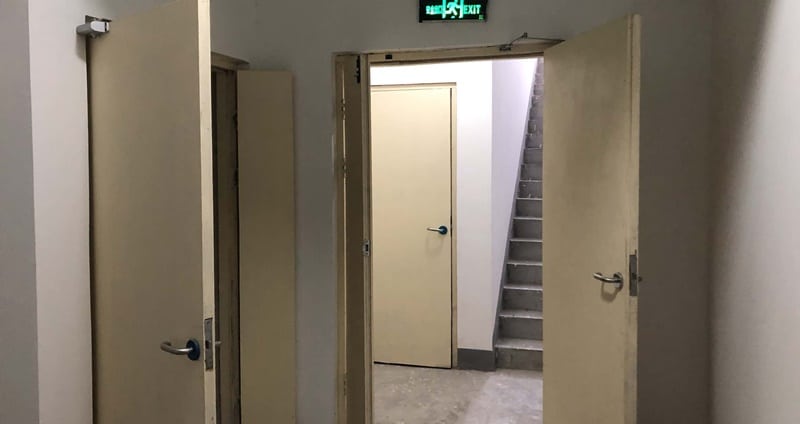
Fire doors are required in various locations within a building to prevent the spread of fire and smoke, provide compartmentalization, and ensure the safety of the occupants. The specific requirements for fire doors may vary depending on local building codes, regulations, and the type of building (residential, commercial, or industrial). However, some general locations where fire doors are typically required include:
- Stairwells: Fire doors are often used to separate stairwells from the rest of the building to prevent the spread of fire and smoke and maintain a safe evacuation route for occupants.
- Corridors and hallways: Fire doors may be required in corridors or hallways to create compartments and limit the spread of fire and smoke between different building sections.
- Fire-rated walls: When a wall has a fire-resistance rating, any door within that wall must have a compatible fire rating to maintain the integrity of the wall’s fire resistance.
- Service and utility rooms: Rooms containing electrical equipment, HVAC systems, or other mechanical installations that pose a fire risk often require fire doors to isolate these areas from the rest of the building.
- Vertical shafts: Fire doors are required to protect openings into vertical posts, such as elevator shafts or refuse chutes, to prevent the spread of fire and smoke through these pathways.
- Fire separation between units: In multi-unit residential or commercial buildings, fire doors may be required between individual units or spaces to provide fire separation and ensure the safety of occupants.
- Exit and escape routes: Fire doors may be used along exit routes and escape paths to ensure occupants have a safe and protected means of egress during a fire emergency.
It is essential to consult local building codes and regulations and work with a qualified architect or fire safety professional to determine the specific fire door requirements for your building. Proper installation, maintenance, and inspection of fire doors are crucial for their effectiveness in a fire.
Which type of door lock is best for a fire door?
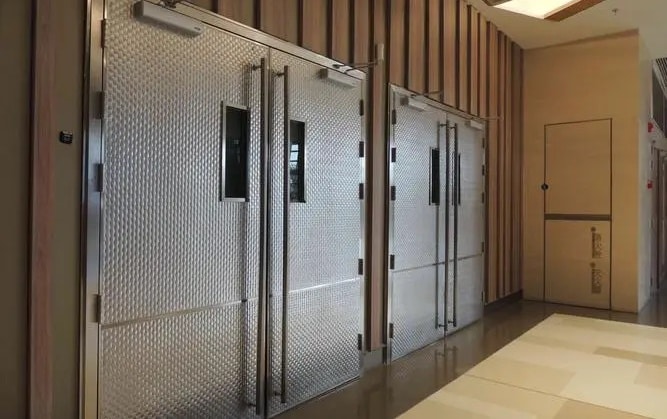
Fire doors require specific hardware to comply with fire safety regulations, including the type of lock installed. These specifications can differ depending on local regulations and guidelines, but here are some general considerations:
- Certified Fire Door Lock: Always choose a certified lock for use on fire doors. This means the lock has been tested and proven not to compromise the door’s ability to withstand fire.
- Type of Lock: Generally, the type of lock used doesn’t affect a door’s fire rating, but there are a few considerations to remember. Mortise locks and cylindrical locks are commonly used on fire doors. The lock should not require a key for egress (leaving the building), as this could trap people inside during a fire.
- Fail Safe vs. Fail Secure: Consider whether a fail-safe or fail-secure model is more appropriate for powered locks like electromagnetic or electric strikes. Fail-safe locks automatically unlock when power is lost, while fail-secure locks remain locked. Fire exit doors should generally use fail-safe locks to ensure people can exit in an emergency.
- Door Closer: Fire doors must always close fully after being opened. This typically requires a self-closing device like a door closer or spring hinge, which isn’t a lock per se but is a crucial part of a fire door’s hardware.
- Panic Bar / Crash Bar: In commercial settings or locations with high occupancy, fire doors often require a panic bar (also known as a crash bar or push bar) to allow for quick, easy exit in case of an emergency.
- Intumescent Material: Locks and other door hardware should be installed with intumescent material, which expands in heat to protect the hardware from the fire and prevent it from creating a weak point in the door.
Always consult with a local expert or your local fire marshal to ensure your specific installation complies with all local and national fire safety regulations.


